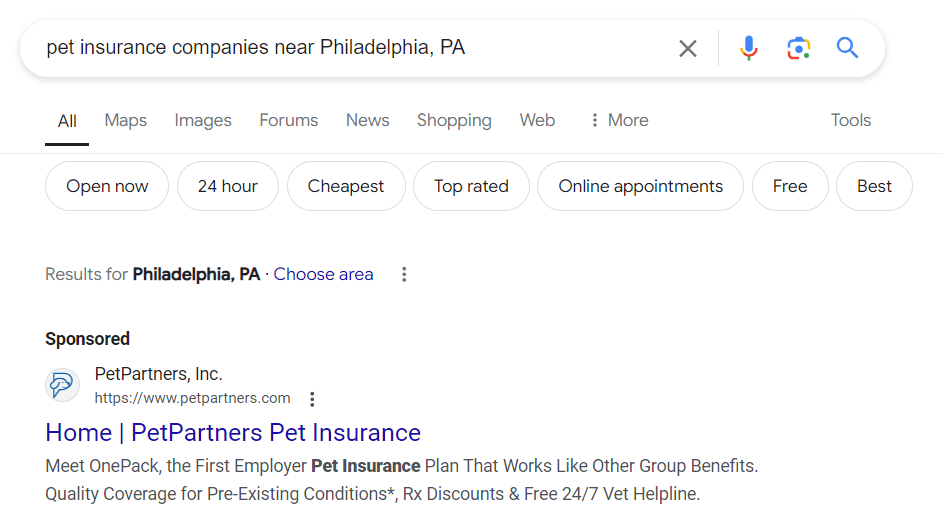- Home
- Industries
- Insurance
- Health Insurance
How To Do Digital Marketing for Health Insurance Companies
Digital marketing for health insurance is key to finding and attracting new clients. Boost your health insurance company’s online presence with strategies like pay-per-click (PPC) ads, search engine optimization (SEO), tailored content, and more.
-
insights from 6,600+ hours of insurance marketing experience
Many health insurance marketers struggle to navigate the industry amidst new laws and regulations. However, digital marketing for health insurance is a must for companies who want to reach more clients and sell more plans.
This page will guide you through different digital marketing methods that are beneficial for health insurance companies. Follow along below:
Digital marketing strategies for health insurance companies
Learning how to do digital marketing for your health insurance company starts with the available channels. Let’s look at the top digital marketing tactics that health insurance providers across the nation use to reach new clients:
SEO
SEO is the main digital marketing tactic to help health insurance companies build their online presence. With SEO, you can attract more users to your website and build your reputation as a respectable insurance company.
For example, while users are researching types of insurance, they might find a page of yours that explains a new topic:

Since people buy insurance at different times in their life and for different reasons, you want to create a lasting impression that they can reference later.
Even though it’s not sales related, this exposure to your company can leave an impression and encourage them to return when they want to buy.
PPC
PPC is a type of advertising method where you only pay when someone clicks on your ad. In search engines, these ads will stand out with a “Sponsored” tag:

Health insurance companies can use PPC to target people actively looking to sign up for insurance. And, since you only pay when someone clicks on your ad, you can better control your budget and tailor it to people who are more likely to convert.
Local SEO
If you want to reach users in a certain area, local SEO for health insurance companies is the way to go.
As seen in the PPC example above, people looking for companies in their area will often use keywords relating to their city to find local companies.
Local SEO tactics will help you find and reach customers in your area that need health insurance services.
Content marketing
Content marketing is the process of creating written or visual content that you share online. A company blog, social media, or even an email newsletter are all types of content.
For example, a friendly email introducing yourself to new clients can build a relationship with them:

When purchasing health insurance, prospects are going to do their own research. Having content on your website and beyond can make it easy for users to find and learn about your company and offerings.
And, if they’re already customers, that content will keep them engaged with your company and encourage them to re-up their plans continuously.
Website maintenance
In most cases, your website is the first interaction customers have with your company. That means if you don’t make a meaningful first impression, you’re missing out on potential clients.
Having an up-to-date website is essential for existing customers, too. If users don’t want to navigate your site, or they feel like it’s unsafe, they might switch to another company.
Investing in website maintenance and design can make a huge impact on how prospects and customers view your company. If you have educational content, a sleek interface, and updated security measures, you can attract and retain more clients.
Conversion rate optimization (CRO)
Once you get users to your website, what do you do? CRO works with your PPC, SEO, and other marketing efforts to turn traffic into conversions.
Effective CRO makes it clear what the next steps are once someone lands on your website. If you want people to reach out or sign up online, you need to tell them how to proceed. You also need to use straightforward design and text to encourage them along the buyer’s journey.
CRO can make all the difference in your other marketing methods and help you get more people to contact you.
5 digital marketing tips for health insurance companies
So, how can you actually do digital marketing for health insurance? Here are some tips for making sure your marketing plan goes as smoothly as possible:
1. Treat each service line separately
As you create your strategy, you should have separate campaigns for Medicare, Individual, and Group. This way, you can properly align your ads with the right audiences and tailor them to specific demographic needs.
If you use a PPC platform like Google Ads, it’s also important to bid on and protect your brand name. Sometimes your competitors will bid on your brand and use it in their advertisements to lure customers searching for you by name. If this happens to you and your brand is trademarked, you can file a complaint.
Along the same lines, you should remember that using your brand name as a keyword is always wise. Many people who are ready to purchase insurance have already done their research — and the easier you make it to find you, the more likely they’ll be to enroll.
2. Align your budget with enrollment rates
There are only small windows of opportunity where Medicare enrollees and individual health insurance enrollees can switch insurance agencies. During these open windows, there will be a huge influx of people looking for coverage. Your insurance marketing budget should correlate with enrollment dates, so you can get the most return on your investment (ROI).
Keep in mind that there are also special enrollment periods based on life events. When someone gets married, for example, they’ll be permitted to join their spouse’s plan. And when they turn 65, they become eligible for Medicare.
Keep your budget targeted for these special enrollment periods.
3. Advertise on multiple platforms
To maximize your reach, you should market on multiple search engines and platforms.
Google is — of course — the powerhouse of search and by far the most popular, but that doesn’t mean you should neglect adverting on Bing, social media sites, and other popular online locations.

Everyone is required by law to have health insurance, which translates to a diverse demographic that is searching for your offerings. Your marketing materials can be effective on a variety of online locations, so find out what your audience prefers and focus your energy on those platforms.
5. Use negative keywords
Negative keywords — or keyword exclusions — are the ones that you don’t want to include in your strategy. Negative keywords are extremely important in health insurance advertising because there are so many types of insurance available.
Be sure to exclude people in the market for car, auto, life, pet, and dental insurance. Also, keep in mind that people who already have health insurance might use specific keywords to access information about their current policy, using keywords like “login” or “make payment”, and they can be excluded as well.
If you haven’t added any to your campaign yet, this list of 25 is a great place to start.
6. Don’t forget to retarget
People looking for health insurance are likely going to shop around before they commit to a policy. This means you should continue to target them after they leave your website. Keep your company fresh in their minds with strategic retargeting.
Bonus Read: 8 More Marketing Ideas for Health Insurance Companies
Drive revenue with digital marketing for health insurance companies
Given its competitive nature, the health insurance industry is a challenge for marketers. If you want to improve your strategy and generate more enrollments, WebFX can help.
With our health insurance marketing services, you get 29 years of experience creating comprehensive digital marketing plans behind your campaign. You can also rely on us to research industry trends and find the best approaches on the market to help your company stand out.
Contact us today to speak with a strategist!
We Drive Results for Health Insurance Companies
- Dedicated account manager backed by 500+ digital experts
- Renowned for our communication and transparency



Table of Contents
- Digital marketing strategies for health insurance companies
- SEO
- PPC
- Local SEO
- Content marketing
- Website maintenance
- Conversion rate optimization (CRO)
- 5 digital marketing tips for health insurance companies
- 1. Treat each service line separately
- 2. Align your budget with enrollment rates
- 3. Advertise on multiple platforms
- 5. Use negative keywords
- 6. Don’t forget to retarget
- Drive revenue with digital marketing for health insurance companies
- We Drive Results for Health Insurance Companies
We Drive Results for Health Insurance Companies
- Dedicated account manager backed by 500+ digital experts
- Renowned for our communication and transparency



Explore our insurance case studies
Read our case studies for a more in-depth look at our results.
Solving key challenges for health insurance
Our website isn’t driving enough traffic
Drive more qualified traffic to your website with digital marketing strategies designed to boost your online visibility and brand awareness.

We’re not attracting new clients
Keep a steady stream of clients coming through your doors with personalized marketing plans from WebFX designed to attract high-value leads to your business.

We’re struggling to sell the new services we offer
Having trouble getting prospects to invest in your new insurance services? Get your services in front of the people who are actively searching for them with WebFX.

We aren’t retaining clients
It costs more money to attract new clients than it does to retain them. Enjoy massive cost savings and more revenue with marketing plans designed to foster client loyalty and long-term relationships.


